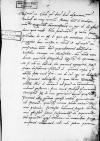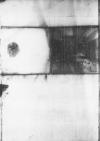Mittit hunc dominum ⌊Grabya⌋ ⌊maiestas reginalis⌋, commonefaciens Vestram Reverendissimam Dominationem de quibusdam, quae male habent suam maiestatem, quod talia sint seminata de Vestra Reverendissima Dominatione, quae est creatura suae maiestatis.
Legatio huc missa a Vestris Dominationibus ad ⌊maiestatem regiam⌋, praesertim autem litterae querulatrices(!) adversus dominum ⌊Kostkka⌋, Campe et Holschte, non omnino arrident ⌊serenissimis principibus⌋. Ego tamen do operam, ut si non in omnibus, certe paucis exceptis, satis fiat desiderio Vestrarum Dominationum, quamvis nescio, quo adverso fato meo fit, ut de cum ego et diligenter, et sincere advigilo, si qua ratione concitatos animos illic Dominationum Vestrarum ad pacem et concordiam inducere possem, fero eius studii superinscribed in place of crossed-out um⌈umii superinscribed in place of crossed-out um⌉ praemium, conceptam scilicet de me opinionem apud quosdam primores illius provinciae, quasi nationi Germanicae non faveam, quod tamen nemo solida ratione convincere poterit. Fortasse liberius scriptae litterae a me quibusdam hanc suspicionem mihi pepererunt. Sed opinentur, quicquid velint, mihi manebit semper constans voluntas, ubi, ubi potero, pacem  AAWO, AB, D. 5, f. 1v et amorem inter homines procurare et quorumlibet necessitatibus et iustitiae, quantum ex me est, consulere.
AAWO, AB, D. 5, f. 1v et amorem inter homines procurare et quorumlibet necessitatibus et iustitiae, quantum ex me est, consulere.
Dominus ⌊Ioannes a Verden⌋ purgat se binis litteri written over a⌈aii written over a⌉s apud ⌊maiestatem regiam⌋ de his, quae ego praemonens ad Vestram Reverendissimam Dominationem scripsi, de quibus tamen maiestati regiae nihil dixeram, sed cum praelegissem litteras domini Verden written over m⌈mnn written over m⌉ maiestati regiae, coactus sum etiam maiestati suae rem, ut se habuit, declarare, sine quo fuisset consultius aliam occasionem praestolari. Multa enim ad nos huc in aulam scribuntur, quae tamen ⌊principibus⌋ non communicantur et plerumque non accusati excusatio parit suspicionem, de quo tamen non vacat plura scribere.
Scio, quod Dominatio Vestra Reverendissima concipiet nonnihil perturbationis ex legatione hac ⌊maiestatis reginalis⌋, in qua, non dubito, adhibebit ingenii sui acumen ad consilium et respondebit ita, ut satisfaciat maiestati suae, quae zelo bono facit, sicuti cum sua creatura.
Plura per dominum ⌊castellanum Gedanensem⌋, cum quo hic non pauca contuli et quem, ubi potero, libenter iuvabo, praesertim ubi licebit etc. Deus servet felicem et incolumem Vestram Reverendissimam Paternitatem.
 AAWO, AB, D. 5, f. 1v et amorem inter homines procurare et quorumlibet necessitatibus et iustitiae, quantum ex me est, consulere.
AAWO, AB, D. 5, f. 1v et amorem inter homines procurare et quorumlibet necessitatibus et iustitiae, quantum ex me est, consulere.


